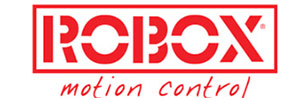 ROBOX sviluppa e produce controlli asse, linguaggi di programmazione e aiuta i suoi clienti a controllare in modo ottimale i loro macchinari industriali
ROBOX sviluppa e produce controlli asse, linguaggi di programmazione e aiuta i suoi clienti a controllare in modo ottimale i loro macchinari industriali
La molteplicità dei linguaggi di programmazione (testo strutturato, ladder, object blocks) e la ricchezza delle librerie rendono facile l’apprendimento dei sistemi Robox a qualunque tecnico con le giuste basi di elettronica ed informatica.
Online è facilissimo raggiungere il canale YouTube Robox SpA e il sotto canale RoboxVideoTutorial, dove sono disponibili molte videolezioni che permettono all’interessato di imparare a lavorare con i principali programmi Robox.
Dal punto di vista hardware, i controlli Robox sono famosi per poter gestire al meglio qualunque macchina, grazie alla varietà di bus di campo con cui comunicano, tra cui Ethercat, CANopen, PROFINET, Modbus, ecc.
 L’attuale prodotto di punta di Robox S.p.A. è l’RP-2, un controllo con processore ARM A9 che può gestire fino a 32 assi interpolati.
L’attuale prodotto di punta di Robox S.p.A. è l’RP-2, un controllo con processore ARM A9 che può gestire fino a 32 assi interpolati.
Dopo il fruttuoso impiego degli I/O safe della Phoenix Contact, Robox ha stretto anche una collaborazione con BBH, azienda tedesca che da più di 30 anni si occupa di sicurezza. I PLC di BBH gestiscono in modo sicuro anche le funzioni matematiche avanzate. Si pensi, ad esempio, alla necessità di controllare in modo sicuro il tool point di un robot (Safely Limited Position), oppure alla necessità di limitare in modo sicuro la velocità di una qualunque macchina operatrice (Safely Limited Speed).
La sinergia dei motion controller Robox e dei PLC di sicurezza BBH offre agli OEM operanti in ogni settore, la possibilità di raggiungere i requisiti di sicurezza funzionale (SLS, SLP, …) anche al TCP. L’accoppiata Robox / BBH ha trovato un’importante applicazione anche nel settore degli AGV, dove Robox opera con successo da decenni. Le aree dei PLS (laser scanner di prossimità) possono ora variare dinamicamente in funzione della velocità del veicolo in modo sicuro.
Il “motion-control” Robox modello RP-2
Proprio come i suoi predecessori (tra cui ricordiamo RBXM, uRMC3 e RP-1), l’RP-2 sta rapidamente conquistando un posto rilevante nella robotica e nell’automazione industriale, con adozioni sempre crescenti nell’ambito di varie macchine e in diversi settori, come confezionatrici (flowpack), riempitrici, tappatrici, cartonatrici, ecc. Anche l’integrazione tra sistemi di controllo e drives è notevolmente aumentata. Sul fronte degli sviluppi hardware, citiamo l’azionamento RID20-E che ha perfezionato e sostituito il precedente RID20. Lungi dall’essere obsoleto, si è ugualmente proceduto ad una riprogettazione per godere dell’evoluzione tecnologica di questi anni. RID20-E è disponibile sia in versione per istallazione diretta sul motore (configurazione shuttle) che per istallazione nelle immediate vicinanze del motore (configurazione nearby). Grazie all’integrazione con il motore, RID20-E si presta all’impiego in tutte le applicazioni multiasse che richiedono drastiche riduzioni dimensionali e di cablaggi, quali ad esempio le applicazioni nei settori beverage”, alimentare e packaging.
www.robox.it
ROBOX, 50 years of activity
ROBOX develops and produces motion controls, programming languages and helps its customers to excellently rule their industrial machines
ROBOX develops and produces axis controls, programming languages and helps its customers to optimally control their industrial machinery.
The multiplicity of programming languages (structured text, ladder, object blocks) and the wealth of libraries make learning Robox systems easy for any technician with the right foundations in electronics and IT.
Online it is very easy to reach the Robox SpA YouTube channel and the RoboxVideoTutorial sub-channel, many video lessons are available that allow the interested party to learn how to work with the main Robox programs.
From a hardware point of view, Robox controls are famous for being able to best manage any machine, thanks to the variety of field buses they communicate with, including Ethercat, CANopen, PROFINET, Modbus, etc.
The current flagship product of Robox S.p.A. is the RP-2, a control with ARM A9 processor that can manage up to 32 interpolated axes.
After the fruitful use of Phoenix Contact safe I/Os, Robox has also entered into a collaboration with BBH, a German company that has been dealing with safety for more than 30 years. BBH PLCs also safely manage advanced mathematical functions. Think, for example, of the need to safely control the tool point of a robot (Safely Limited Position), or the need to safely limit the speed of any operating machine (Safely Limited Speed).
The synergy of Robox motion controllers and BBH safety PLCs offers OEMs operating in every sector the possibility of achieving functional safety requirements (SLS, SLP, …) also for TCP. The Robox / BBH combination has also found an important application in the AGV sector, where Robox has been operating successfully for decades. The areas of the PLS (proximity laser scanners) can now vary dynamically according to the speed of the vehicle in a safe way.
The “motion-control” Robox model RP-2
Just like its predecessors (among which we remember RBXM, uRMC3 and RP-1), the RP-2 is rapidly gaining an important place in robotics and industrial automation, with ever-increasing adoptions in various machines and in different sectors, such as flowpack machines, fillers, cappers, case packers, etc. The integration between control systems and drives has also significantly increased. On the hardware development front, we mention the RID20-E drive which perfected and replaced the previous RID20. Far from being obsolete, a redesign was also carried out to take advantage of the technological evolution of recent years. RID20-E is available both in the version for direct installation on the engine (shuttle configuration) and for installation in the immediate vicinity of the engine (nearby configuration). Thanks to the integration with the motor, RID20-E is suitable for use in all multi-axis applications that require drastic reductions in size and wiring, such as applications in the beverage”, food and packaging sectors









